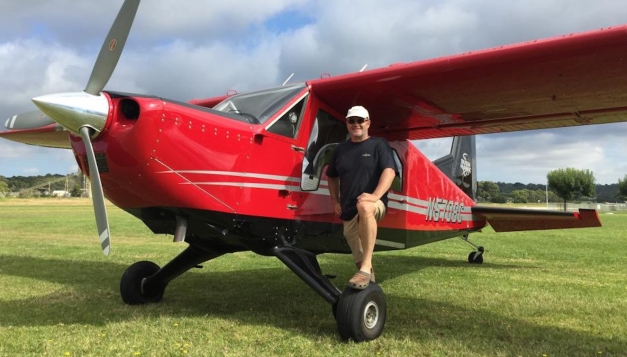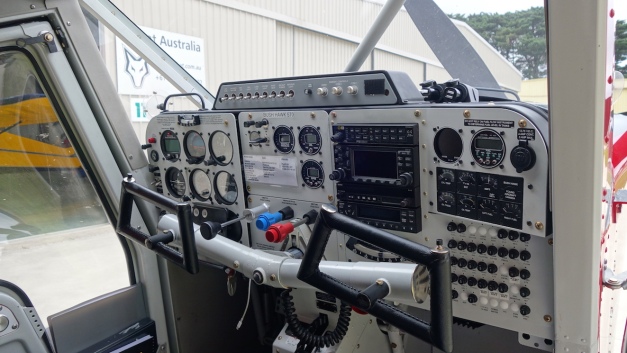 Last Saturday I went for my first flight in Stephen’s Found Aircraft Bush Hawk – what a great experience!
Last Saturday I went for my first flight in Stephen’s Found Aircraft Bush Hawk – what a great experience!
You may recall from a previous post that this Bush Hawk arrived in Australia from Alaska in November last year. Since then, Stephen has been flying it to gain his RPL and get used to an aircraft that is very, very different from the Carbon Cubs he flies and sells in Australia.
Although the aircraft is physically big – at least to us mere LSA pilots – the first thing that you notice is how easy it is to get into (and out of). There’s a step on the main gear leg, two big forward opening front doors and no stick to contort yourself over. The next thing that strikes you is how small the control yokes feel; can they really control such a monster? However, the yokes themselves are mounted on a Y-shape tube which would do justice to the Sydney Harbour Bridge…
The next thing that strikes you is how small the control yokes feel; can they really control such a monster? However, the yokes themselves are mounted on a Y-shape tube which would do justice to the Sydney Harbour Bridge…
Buckling in, there’s a 5-point harness (is this plane aerobatic? Surely not) with inertia-reel shoulder straps. The door closes with a satisfying clunk and if you want a really tight seal, you can optionally operate the corner latches to secure it. One interesting aspect of this aircraft is that there are also two rear doors to access the cavernous rear cargo/seating area, which although currently fitted with three rear passenger seats, still leaves a baggage area behind them which is bigger than many estate wagons!
Considering it’s a taildragger, the view over the long nose isn’t bad – although that will likely change when Stephen fits the big bush tyres, which will lift the front by several inches. The upright seating position is comfortable but feels a bit like a truck, something which is further prompted by the view along the ‘bonnet’ as Stephen fires up the 300 hp 6-cylinder engine. The starter spins the prop at a rapid pace – much faster than my old Interstate – and soon the engine has settled down to a subdued rumble. In spite of a plethora of dials and digital instruments, all the basic indicators are easy to recognise and monitor. Warming up such a beast takes a while at around 1,100 rpm, during which the fuel flow meter shows a steady 15 litres an hour. For someone used to a cruise fuel consumption of not much more than that, this takes a little while to absorb…
Once warmed up, we’re on the move. The suspension is surprisingly compliant, particularly considering we are at least 350 kgs under gross weight. All the lumps in the Tyabb grass are nicely soaked up as we taxi to runway 35 for departure. After an engine run-up and c/s prop check, we’re ready; a few final checks of the harnesses and doors and off we go. There’s a very strong shove in the back as the engine hits peak take-off rpm and in no time at all we’re flying. The fuel flow meter reads 85 litres an hour…
Inside, the noise is subdued – in part due to the excellent Bose ANR headsets. Outside, I know the aircraft is making quite a noise, a characteristic of a propeller running full speed at fine pitch. Climb out is not particularly steep but the forward speed contributes to a rate of climb well over 1,000 fpm.
After take-off we make a right turn and head out over the water for a clockwise circumnavigation of nearby French Island. Stephen trims out, leans off the engine a little and hands over to me. Now, the control yokes really do feel very small! Although the aircraft feels quite stable, it’s easy to turn, using a bit of rudder to keep the ball in the middle. Steeper turns need a little back pressure to maintain height but in all other senses the aircraft is just a big pussy cat and really nice to fly. At a cruise of around 115 knots, the fuel flow meter reads 49 litres an hour…
All too soon, we are round the island and Stephen takes over for the approach and landing. I am told this aircraft drops like a stone when you take off the power and add flap. If so, it doesn’t feel like it – Stephen’s many hours of practice have smoothed out all the lumpy bits. We turn on to final at around 70 knots, reducing just a little to 65 on short final. The landing felt great to me but Stephen’s a bit of a perfectionist and felt he arrived a bit to soon. But there was no bounce and the aircraft settled nicely on the grass. You can see the video I made of the approach by clicking the picture below.
[wpvideo AO2BgADm]
Overall, I enjoyed this short flight; the Bush Hawk seems easy to fly – at least on this no-wind, smooth-air day. It feels and sounds a bit like a big luxurious truck, with its long nose and 6-cylinder engine beat. The fuel burn took my breath away but if you want an aircraft like this, low fuel consumption is not too near the top of your priority list. However, the Bush Hawk will carry up to 5 people and their baggage, in relative comfort, into and out of bush strips. It has a relaxed cruise in the 115-125 knot range, so you can get to those far-away places reasonably quickly. Which is exactly what it was designed to do. It’s a shame that Found Aircraft could not make their business work – they certainly deserved a better destiny after designing and building this superb aircraft.

Pingback: 170s in the Wrangells | Foxbat Pilot